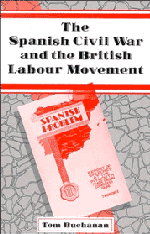Book contents
- Frontmatter
- Contents
- Preface
- List of abbreviations
- Introduction: ‘The Spanish problem’
- 1 ‘The best that could be done at the time…’: Non-Intervention, 17 July–28 October 1936
- 2 Breaking with Non-Intervention: October 1936–October 1937
- 3 The failure of the left: October 1937–April 1939
- 4 ‘A demonstration of solidarity and sympathy…': The Spanish Workers' Fund and its competitors
- 5 Opposition: Catholic workers and the Spanish Civil War
- 6 Rank-and-file initiatives
- Aftermath and conclusion
- Bibliography
- Index
4 - ‘A demonstration of solidarity and sympathy…': The Spanish Workers' Fund and its competitors
Published online by Cambridge University Press: 05 January 2012
- Frontmatter
- Contents
- Preface
- List of abbreviations
- Introduction: ‘The Spanish problem’
- 1 ‘The best that could be done at the time…’: Non-Intervention, 17 July–28 October 1936
- 2 Breaking with Non-Intervention: October 1936–October 1937
- 3 The failure of the left: October 1937–April 1939
- 4 ‘A demonstration of solidarity and sympathy…': The Spanish Workers' Fund and its competitors
- 5 Opposition: Catholic workers and the Spanish Civil War
- 6 Rank-and-file initiatives
- Aftermath and conclusion
- Bibliography
- Index
Summary
The scope of the British labour movement's commitment to humanitarian relief work in Spain was undeniable, and by the end of the Civil War, it had contributed some £200,000 worth of supplies to the Republican side. Moreover, major responsibilities were accepted, such as the maintenance of a field hospital in Spain and the care of 4,000 Basque refugee children in Britain. The relief effort was the centrepiece of the movement's response to the war and something which the leaders could readily allude to when challenged by those who claimed that not enough was being done to help Republican Spain. Yet, beyond these bare facts, this area of labour's response was still surprisingly controversial. Critics at the time argued that the labour movement's campaign was politically and organisationally inflexible; that it failed both to mobilise the potential within the movement itself, while also missing the opportunity to work with other political parties and to make inroads into wealthier sections of society beyond the working class. In particular, it was claimed that labour was paralysed by its opposition to communism, which prevented it from developing a more expansive campaign.
This critique has been taken up by historians who have argued that a grouping of organisations occupied the space abandoned by the labour movement and successfully mobilised rank-and-file support, while also involving activists from other parties and social classes.
- Type
- Chapter
- Information
- The Spanish Civil War and the British Labour Movement , pp. 137 - 166Publisher: Cambridge University PressPrint publication year: 1991



